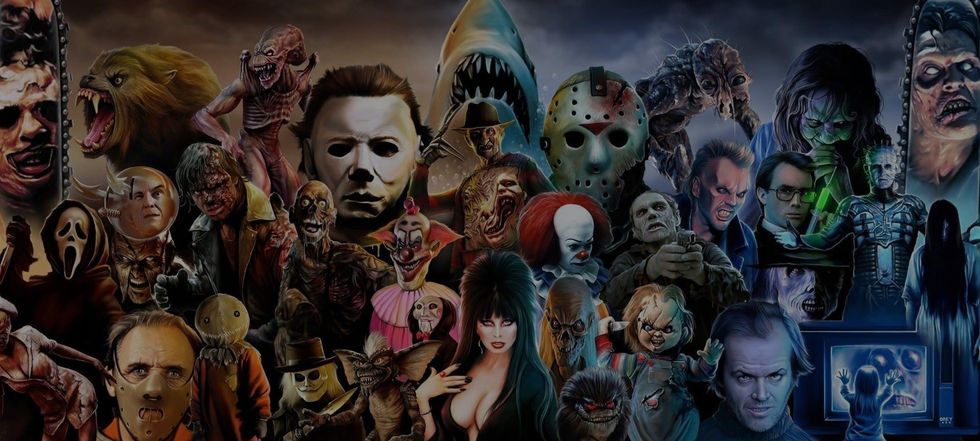I freaking love horror, okay? In my opinion, it's one of the best genres because of one solitary factor: it is so easy to mess up.
Making something truly terrifying requires the same amount of precision as a neurosurgeon with a scalpel yet the creativity and understanding of human beings that walks hand in hand with true artistry.
And, you know, the blood and guts and stuff can be fun.
Some of you are bound to feel the same way, so I ask you to take up arms and accept my challenge to watch 31 of some of the best horror movies of all time, all within the spookiest month of the year. This list spans from the comedic, to the classic, to the downright nightmare-inducing, so please take caution and don't try to watch them all at once. I'd recommend watching them in order as they are listed chronologically (this will allow for a fuller view of the human experience regarding the horror genre).
Go on, watch them all...unless you think you can't handle a little bit of fright in your life.
I dare you.
1. THE CABINET OF DR. CALIGARI (DAS CABINET DES DR. CALIGARI) (1920)

In one of the most influential films of the silent era, Werner Krauss plays the title character, a sinister hypnotist who travels the carnival circuit displaying a somnambulist named Cesare (Conrad Veidt). In one tiny German town, a series of murders coincides with Caligari's visit. When the best friend of hero Francis (Friedrich Feher) is killed, the deed seems to be the outgrowth of a romantic rivalry over the hand of the lovely Jane (Lil Dagover). Francis suspects Caligari, but he is ignored by the police. Investigating on his own, Francis seemingly discovers that Caligari has been ordering the somnambulist to commit the murders, but the story eventually takes a more surprising direction. Caligari's Expressionist style ultimately led to the dark shadows and sharp angles of the film noir urban crime dramas of the 1940s, many of which were directed by such German émigrés as Billy Wilder and Robert Siodmak.
2. NOSFERATU, A SYMPHONY OF HORROR (NOSFERATU, EINE SYMPHONIE DES GRAUENS) (NOSFERATU THE VAMPIRE) (1922)
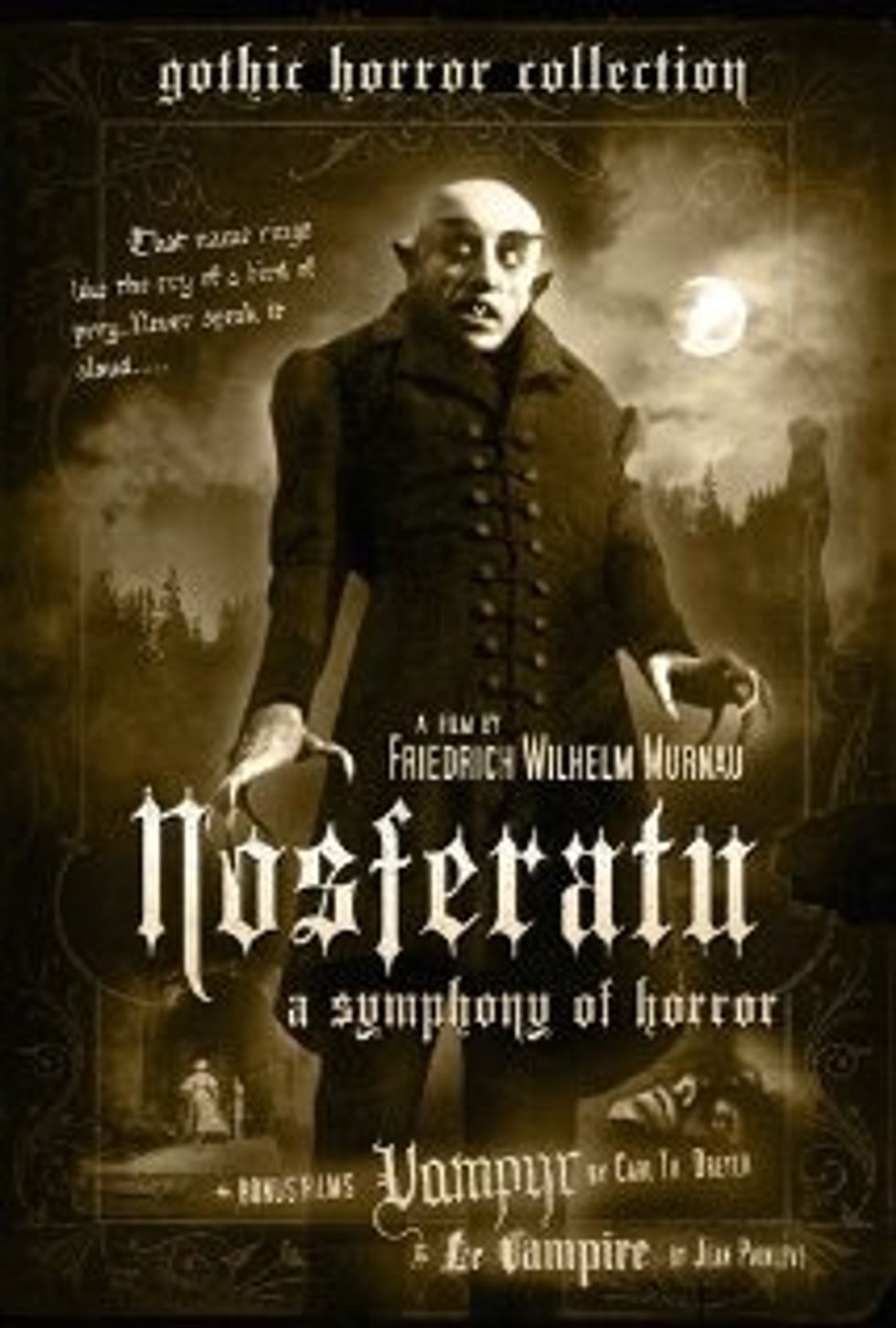
F. W. Murnau's landmark vampire film begins in the Carpathian mountains, where real estate agent Hutter has arrived to close a sale with the reclusive Herr Orlok. Despite the feverish warnings of the local peasants, Hutter journeys to Orlok's sinister castle. Hutter soon discovers that Orlok is no ordinary mortal.
3. FRANKENSTEIN (1931)
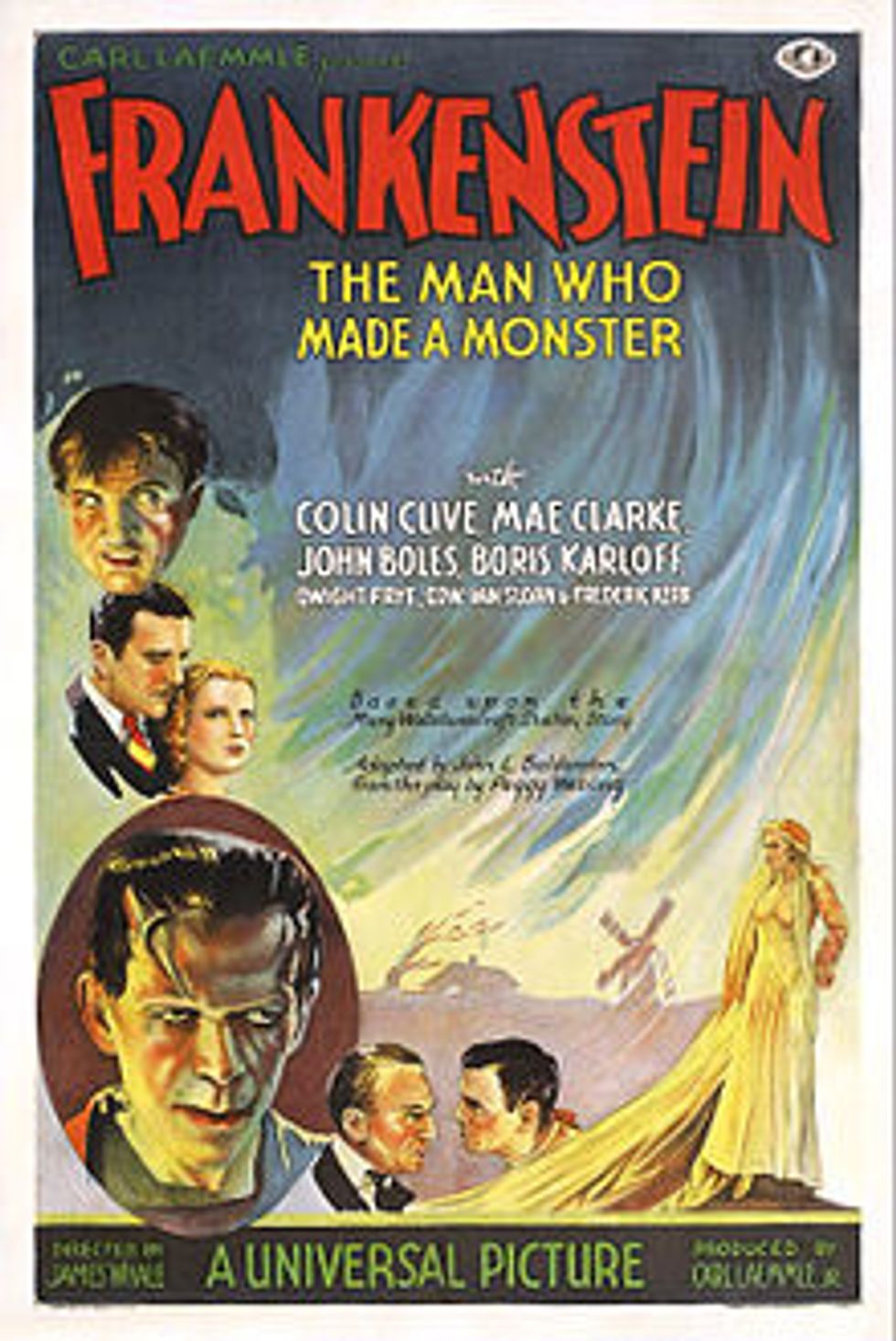
"Frankenstein" is a film about a mad, obsessed scientist, Dr. Henry Frankenstein", who creates a monster, by taking body parts from dead people. Upon placing a brain inside the head of the monster, Henry and his assistant Fritz are amazed that the experiment is alive. When the monster mistakenly kills Maria, a young girl he meets down by the river, the town is up in arms and aims to bring the monster to justice. They find the monster and his creator in an old windmill, where the monster is attempting to kill his maker.
4. THE INVISIBLE MAN (1933)
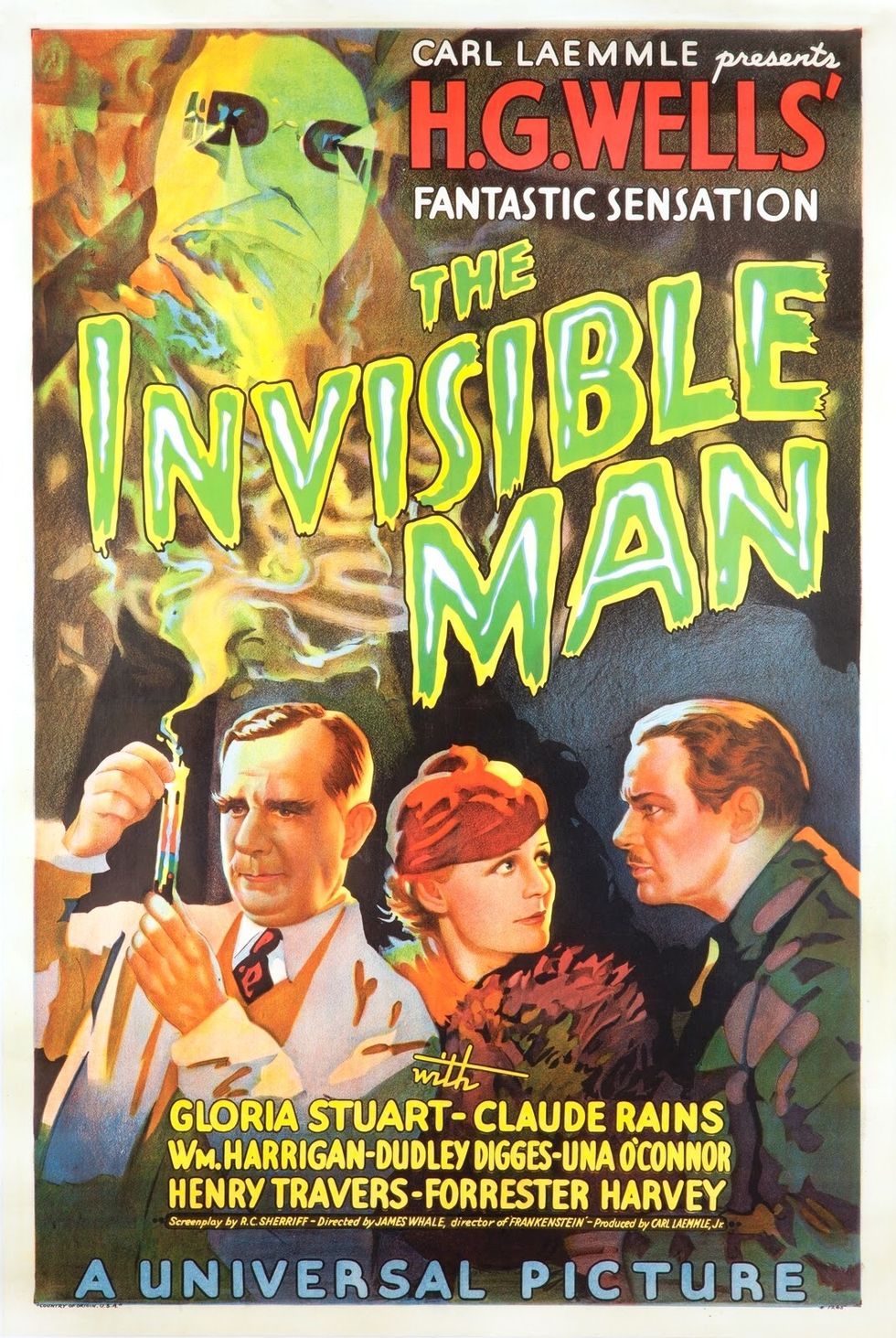
A mysterious stranger, his face swathed in bandages and his eyes obscured by dark spectacles, has taken a room at a cozy inn in the British village of Ipping. Never leaving his quarters, the stranger demands that the staff leave him completely alone. Working unmolested with his test tubes, the stranger does not notice when the landlady inadvertently walks into his room one morning. But she notices that her guest seemingly has no head! The stranger, one Jack Griffin, is a scientist, who'd left Ipping several months earlier while conducting a series of tests with a strange new drug called monocane. He returns to the laboratory of his mentor, Dr. Cranley (Henry Travers), where he reveals his secret to onetime partner Dr. Kemp (William Harrigan) and former fiancee Flora Cranley (Gloria Stuart). Monocane is a formula for invisibility and has rendered Griffin's entire body undetectable to the human eye. Alas, monocane has also had the side effect of driving Griffin insane. With megalomanic glee, Griffin takes Kemp into his confidence, explaining how he plans to prove his superiority over other humans by wreaking as much havoc as possible. At first, his pranks are harmless; then, without batting an eyelash, he turns to murder, beginning with the strangling of a comic-relief constable. When Kemp tries to turn Griffin over to the police, he himself is marked for death. Despite elaborate measures taken by the police, Griffin is able to murder Kemp, considerately taking the time to describe his homicidal methods to his helpless victim. After a reign of terror costing hundreds of lives, Griffin is cornered in a barn, his movements betrayed by his footsteps in the snow. Mortally wounded by police bullets, Griffin is taken to a hospital, where he regretfully tells Flora that he's paying the price for meddling into Things Men Should Not Know. As Griffin dies, his face becomes slowly visible: first the skull, then the nerve endings, then layer upon layer of raw flesh, until he is revealed to be Claude Rains, making his first American film appearance. So forceful was Rains' verbal performance as "The Invisible One" that he became an overnight movie star (after nearly twenty years on stage). Wittily scripted by R.C. Sherriff and an uncredited Philip Wylie, and brilliantly directed by James Whale, The Invisible Man is a near-unstoppable combination of horror and humor. Also deserving of unqualified praise are the thoroughly convincing special effects by John P. Fulton and John Mescall. With the exception of The Invisible Man Returns, none of the sequels came anywhere close to the quality of the 1933 original. Trivia alert: watch for Dwight "Renfield" Frye as a bespectacled reporter, Walter Brennan as the man whose bicycle was stolen, and John Carradine as the fellow in the phone booth who's "gawt a plan to ketch the h'invisible man." ~ Hal Erickson, Rovi
5. DEAD OF NIGHT (1945)

A phone rings. Architect Mervyn Johns is wakened from a nightmare and summoned to the country estate of Roland Culver. Here he meets several strangers, all of whom seem vaguely familiar to him. The conversation turns to nightmares, with each guest relating a recent disturbing dream or real-life event. Anthony Baird weaves a tale about being invited into a hearse with the words "Room for one more, sir." Teen-ager Sally Ann Howes speaks of the time that she met a strange, melancholy child dressed in 19th-century garb during a birthday party. Googie Withers recalls with a shudder how an antique mirror purchased by her husband Ralph Michael nearly prompted her strangulation. There is a comic interlude involving golfers Basil Radford and Naunton Wayne, one of whom is flummoxed by the ubiquitous ghost of the other. The best is saved until last: the story of unbalanced ventriloquist Michael Redgrave and his malevolent dummy. At the end of this round-robin, Johns suddenly and without warning kills psychiatrist Frederick Valk -- just as he predicted that he would. Johns runs from the house, confronting scenes from the various aforementioned nightmares, and then finds himself safe in his own bed. It's all been a horrible dream. And then, the phone rings, and Johns is summoned to the country estate of Roland Culver.....Perhaps the single most influential "portmanteau" film ever made, Dead of Night was for years available only in a crudely re-edited version, eliminated the Sally Ann Howes and the "golfing" vignettes. Even when fully restored, the full effect of the film was lost whenever some thick-witted projectionist would shut off the film before the "deja vu" closing credits.
6. INVASION OF THE BODY SNATCHERS (1956)

Director Don Siegel's thinly-veiled examination of McCarthy-era hysteria stars Kevin McCarthy (no relation) as Miles Bennell, a California doctor who arrives at a San Francisco hospital in near-hysterical condition, raving about an alien invasion. His story, told in flashback, focuses on Bennell's home in tiny Santa Mira, where he discovers an alien plot to take over earth by methodically replacing humankind with zombie-like pod people.
7. THE FLY (1958)

Wealthy Helene Delambre (Patricia Owens) is discovered late at night in the factory owned by her husband Andre (David Hedison). Helene stands beside a huge metal press, which has crushed the head and arm of her husband. Held for murder, the near-catatonic Helene refuses to tell anyone--not even Andre's brother Francois (Vincent Price)--why she did it. Francois cannot help but notice that Helene reacts in mortal terror when a tiny flies zips through the room. Nor can he disregard the statement made by Helene's son Philippe (Charles Herbert) that the fly has a curious white head and leg. When Francois pretends that he's captured the fly, Helene relaxes enough to tell her story. It seems that Andre, a scientist, had been working on a matter transmitter, which he claimed could disintegrate matter, then reintegrate it elsewhere. After a few experiments, Andre tried the transmitter himself. Just as he stepped into the disintegration chamber, a fly also flew into the chamber. We aren't immediately shown the results of this, save for the fact that Andre afterward insists upon keeping his head and arm covered. Alone with her husband, Helene abruptly removes the covering, revealing that Andre now bears the head of a fly! His atoms have become mixed up with the fly, and now he is unable to reverse the procedure. Deciding that his transmitter will be a bogy rather than a blessing to mankind, Andre smashes the apparatus and burns his notes. He then instructs Helene, via body language, to crush his fly-like head and arm in the press. Neither Francois nor inspector Charas (Herbert Marshall) believes the story...until, while staring intently at a spider's web in the garden, they see a tiny entrapped fly with Andre's head and arm, tinnily screaming "Help me! Help me!" as the slavering spider approaches (If you're wondering why Vincent Price and Herbert Marshall do not look one another in the eye during this scene, it is because they couldn't deliver their dialogue without dissolving into laughter). ~ Hal Erickson, Rovi
8. PSYCHO (1960)

In 1960, Alfred Hitchcock was already famous as the screen's master of suspense (and perhaps the best-known film director in the world) when he released Psycho and forever changed the shape and tone of the screen thriller. From its first scene, in which an unmarried couple balances pleasure and guilt in a lunchtime liaison in a cheap hotel (hardly a common moment in a major studio film in 1960), Psycho announced that it was taking the audience to places it had never been before, and on that score what followed would hardly disappoint. Marion Crane (Janet Leigh) is unhappy in her job at a Phoenix, Arizona real estate office and frustrated in her romance with hardware store manager Sam Loomis (John Gavin). One afternoon, Marion is given $40,000 in cash to be deposited in the bank. Minutes later, impulse has taken over and Marion takes off with the cash, hoping to leave Phoenix for good and start a new life with her purloined nest egg. 36 hours later, paranoia and exhaustion have started to set in, and Marion decides to stop for the night at the Bates Motel, where nervous but personable innkeeper Norman Bates (Anthony Perkins) cheerfully mentions that she's the first guest in weeks, before he regales her with curious stories about his mother. There's hardly a film fan alive who doesn't know what happens next, but while the shower scene is justifiably the film's most famous sequence, there are dozens of memorable bits throughout this film. The first of a handful of sequels followed in 1983, while Gus Van Sant's controversial remake, starring Vince Vaughn and Anne Heche, appeared in 1998. ~ Mark Deming, Rovi
9. THE BIRDS (1963)

The story begins as an innocuous romantic triangle involving wealthy, spoiled Melanie Daniels (Tippi Hedren), handsome Mitch Brenner (Rod Taylor), and schoolteacher Annie Hayworth (Suzanne Pleshette). The human story begins in a San Francisco pet shop and culminates at the home of Mitch's mother (Jessica Tandy) at Bodega Bay, where the characters' sense of security is slowly eroded by the curious behavior of the birds in the area. At first, it's no more than a sea gull swooping down and pecking at Melanie's head. Things take a truly ugly turn when hundreds of birds converge on a children's party. There is never an explanation as to why the birds have run amok, but once the onslaught begins, there's virtually no letup. ~ Hal Erickson, Rovi
10. ROSEMARY'S BABY (1968)

In Roman Polanski's first American film, adapted from Ira Levin's horror bestseller, a young wife comes to believe that her offspring is not of this world. Waifish Rosemary Woodhouse (Mia Farrow) and her struggling actor husband, Guy (John Cassavetes), move into the Bramford, an old New York City apartment building with an ominous reputation and only elderly residents. Neighbors Roman and Minnie Castevet (Sidney Blackmer and Ruth Gordon) soon come nosing around to welcome the Woodhouses to the building; despite Rosemary's reservations about their eccentricity and the weird noises that she keeps hearing, Guy starts spending time with the Castevets. Shortly after Guy lands a plum Broadway role, Minnie starts showing up with homemade chocolate mousse for Rosemary. When Rosemary becomes pregnant after a mousse-provoked nightmare of being raped by a beast, the Castevets take a special interest in her welfare. As the sickened Rosemary becomes increasingly isolated, she begins to suspect that the Castevets' circle is not what it seems. The diabolical truth is revealed only after Rosemary gives birth, and the baby is taken away from her. Polanski's camerawork and Richard Sylbert's production design transform the realistic setting (shot on-location in Manhattan's Dakota apartment building) into a sinister projection of Rosemary's fears, chillingly locating supernatural horror in the familiar by leaving the most grotesque frights to the viewer's imagination. This apocalyptic yet darkly comic paranoia about the hallowed institution of childbirth touched a nerve with late-'60s audiences feeling uneasy about traditional norms. Produced by B-horror maestro William Castle, Rosemary's Baby became a critically praised hit, winning Gordon an Oscar for Best Supporting Actress. Inspiring a wave of satanic horror from The Exorcist (1973) to The Omen (1976), Rosemary's Baby helped usher in the genre's modern era by combining a supernatural story with Alfred Hitchcock's propensity for finding normality horrific. ~ Lucia Bozzola, Rovi
11. THE EXORCIST (1973)

Novelist William Peter Blatty based his best-seller on the last known Catholic-sanctioned exorcism in the United States. Blatty transformed the little boy in the 1949 incident into a little girl named Regan, played by 14-year-old Linda Blair. Suddenly prone to fits and bizarre behavior, Regan proves quite a handful for her actress-mother, Chris MacNeil (played by Ellen Burstyn, although Blatty reportedly based the character on his next-door neighbor Shirley MacLaine). When Regan gets completely out of hand, Chris calls in young priest Father Karras (Jason Miller), who becomes convinced that the girl is possessed by the Devil and that they must call in an exorcist: namely, Father Merrin (Max von Sydow). His foe proves to be no run-of-the-mill demon, and both the priest and the girl suffer numerous horrors during their struggles. The Exorcist received a theatrical re-release in 2000, in a special edition that added 11 minutes of footage trimmed from the film's original release and digitally enhanced Chris Newman's Oscar-winning sound work. ~ Hal Erickson, Rovi
12. JAWS (1975)

Based on Peter Benchley's best-selling novel, Steven Spielberg's 1975 shark saga set the standard for the New Hollywood popcorn blockbuster while frightening millions of moviegoers out of the water. One early summer night on fictional Atlantic resort Amity Island, Chrissie decides to take a moonlight skinny dip while her friends party on the beach. Yanked suddenly below the ocean surface, she never returns. When pieces of her wash ashore, Police Chief Brody (Roy Scheider) suspects the worst, but Mayor Vaughn (Murray Hamilton), mindful of the lucrative tourist trade and the approaching July 4th holiday, refuses to put the island on a business-killing shark alert. After the shark dines on a few more victims, the Mayor orders the local fishermen to catch the culprit. Satisfied with the shark they find, the greedy Mayor reopens the beaches, despite the warning from visiting ichthyologist Hooper (Richard Dreyfuss) that the attacks were probably caused by a far more formidable Great White. One more fatality later, Brody and Hooper join forces with flinty old salt Quint (Robert Shaw), the only local fisherman willing to take on a Great White--especially since the price is right. The three ride off on Quint's boat "The Orca," soon coming face to teeth with the enemy. ~ Lucia Bozzola, Rovi
13. HALLOWEEN (1978)
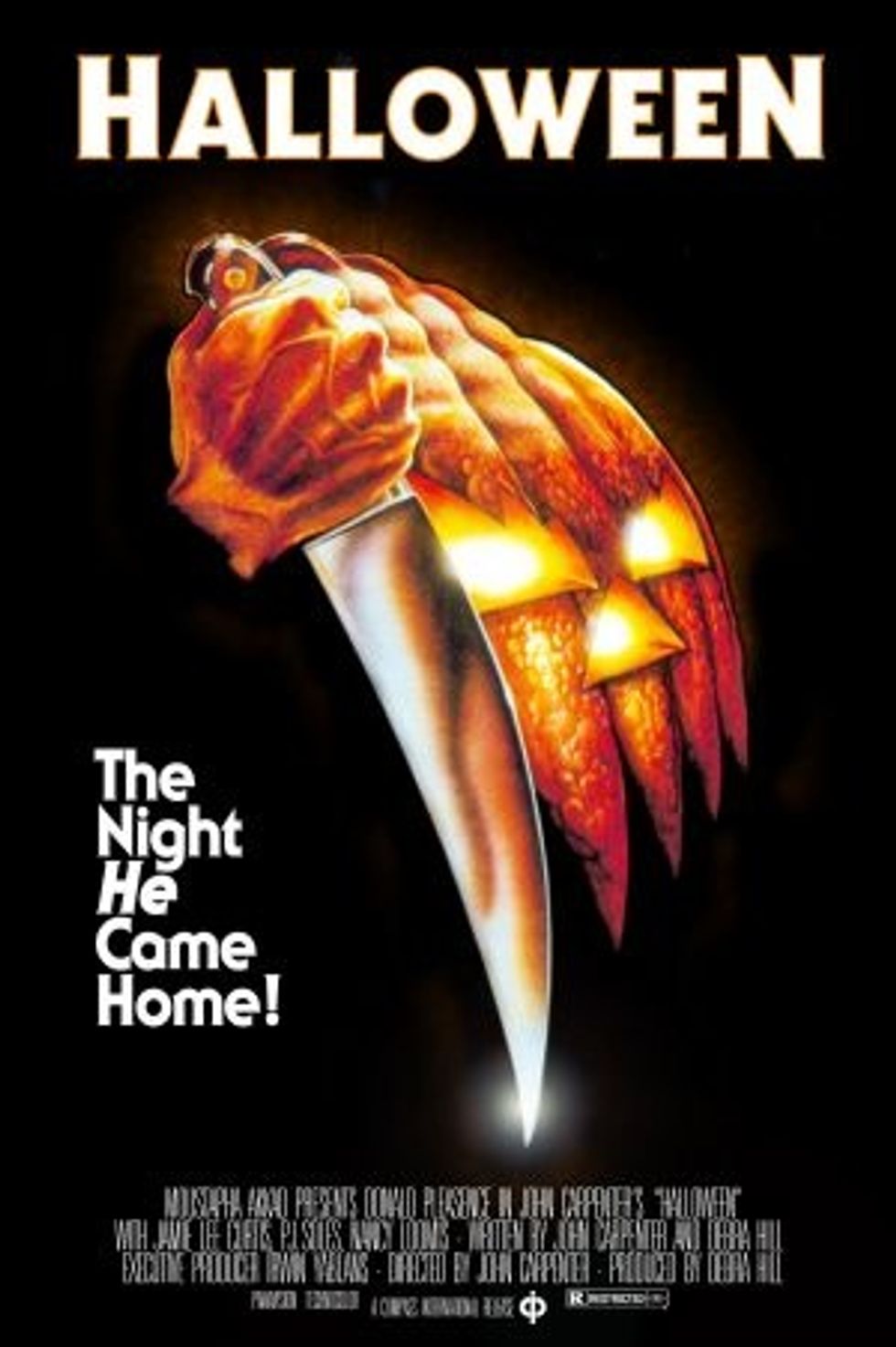
"Scary, suspenseful, and viscerally thrilling, Halloween set the standard for modern horror films."
A young boy kills his sister on Halloween of 1963, and is sent to a mental hospital. 15 years later he escapes and returns to his home town in order to wreak havoc.
14. ALIEN (1979)
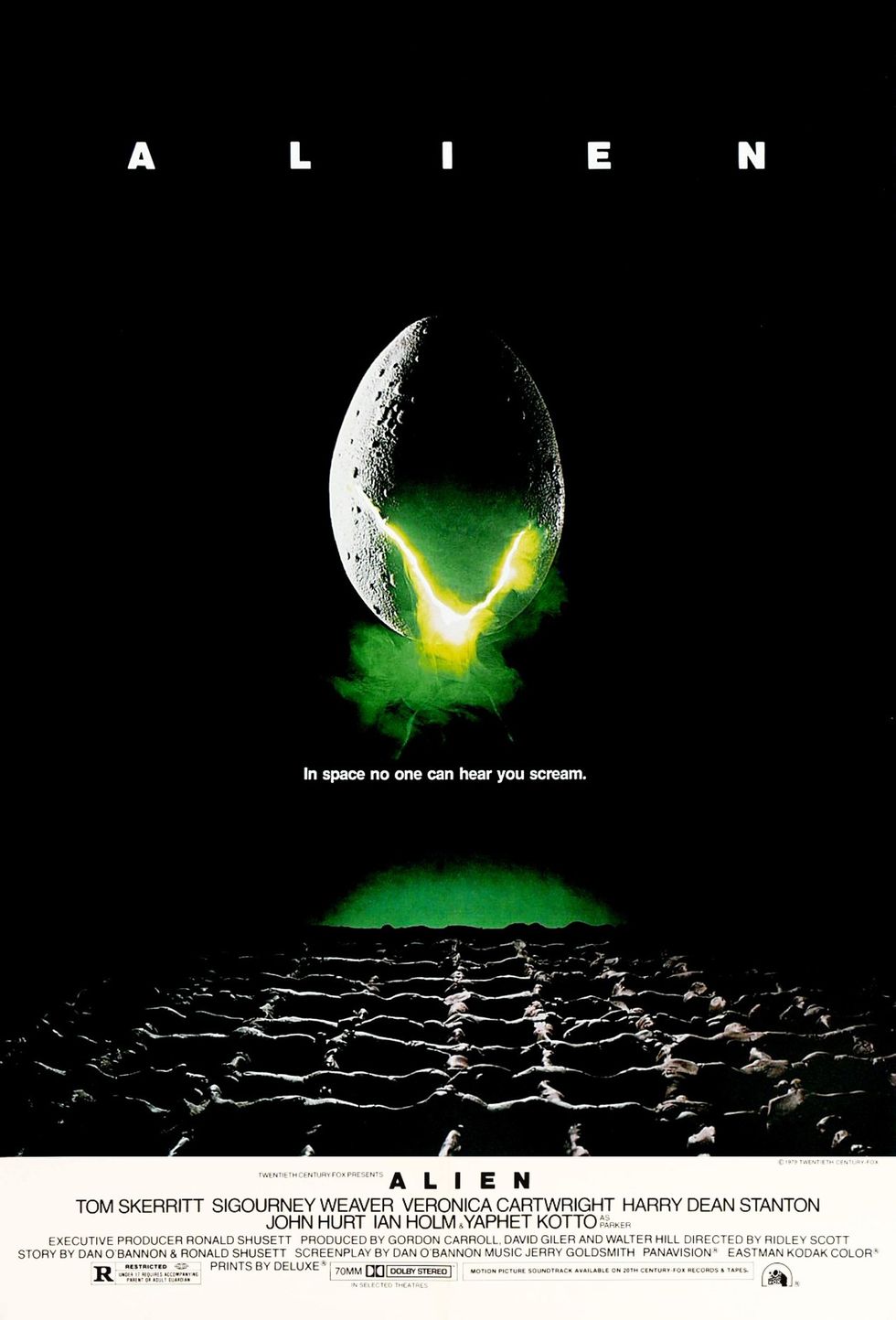
"A modern classic, Alien blends science fiction, horror and bleak poetry into a seamless whole."
"In space, no one can hear you scream." A close encounter of the third kind becomes a Jaws-style nightmare when an alien invades a spacecraft in Ridley Scott's sci-fi horror classic. On the way home from a mission for the Company, the Nostromo's crew is woken up from hibernation by the ship's Mother computer to answer a distress signal from a nearby planet. Capt. Dallas's (Tom Skerritt) rescue team discovers a bizarre pod field, but things get even stranger when a face-hugging creature bursts out of a pod and attaches itself to Kane (John Hurt). Over the objections of Ripley (Sigourney Weaver), science officer Ash (Ian Holm) lets Kane back on the ship. The acid-blooded incubus detaches itself from an apparently recovered Kane, but an alien erupts from Kane's stomach and escapes. The alien starts stalking the humans, pitting Dallas and his crew (and cat) against a malevolent killing machine that also has a protector in the nefarious Company. ~ Lucia Bozzola, Rovi
15. DAWN OF THE DEAD (1979)

Viewers who haven't seen George Romero's low-budget horror masterpiece Night of the Living Dead, might be at a loss during the first sequences of Dawn of the Dead. The opening scenes rely so much on familiarity with the earlier film that it might cause resentment among the uninitiated. But once the story gets started, plot and exposition matter not a whit. Dawn is set in a deserted shopping mall, where the ever-increasing zombie contingent from the first film have set up a sort of Condominium for the Condemned. From this vantage point, the flesh-eating creatures plan to overtake the entire country. There's a lot of allegory and hidden meaning around, but Tom Savini's excellent (and unremittingly gruesome) special effects take center stage throughout. Dawn of the Dead is not recommended for those who have trouble keeping their popcorn down.
16. THE SHINING (1980)

"All work and no play makes Jack a dull boy" -- or, rather, a homicidal boy in Stanley Kubrick's eerie 1980 adaptation of Stephen King's horror novel. With wife Wendy (Shelley Duvall) and psychic son Danny (Danny Lloyd) in tow, frustrated writer Jack Torrance (Jack Nicholson) takes a job as the winter caretaker at the opulently ominous, mountain-locked Overlook Hotel so that he can write in peace. Before the Overlook is vacated for the Torrance's, the manager (Barry Nelson) informs Jack that a previous caretaker went crazy and slaughtered his family; Jack thinks it's no problem, but Danny's "shining" hints otherwise. Settling into their routine, Danny cruises through the empty corridors on his Big Wheel and plays in the topiary maze with Wendy, while Jack sets up shop in a cavernous lounge with strict orders not to be disturbed. Danny's alter ego, "Tony," however, starts warning of "redrum" as Danny is plagued by more blood-soaked visions of the past, and a blocked Jack starts visiting the hotel bar for a few visions of his own. Frightened by her husband's behavior and Danny's visit to the forbidding Room 237, Wendy soon discovers what Jack has really been doing in his study all day, and what the hotel has done to Jack. ~ Lucia Bozzola, Rovi
17. THE EVIL DEAD (1981)
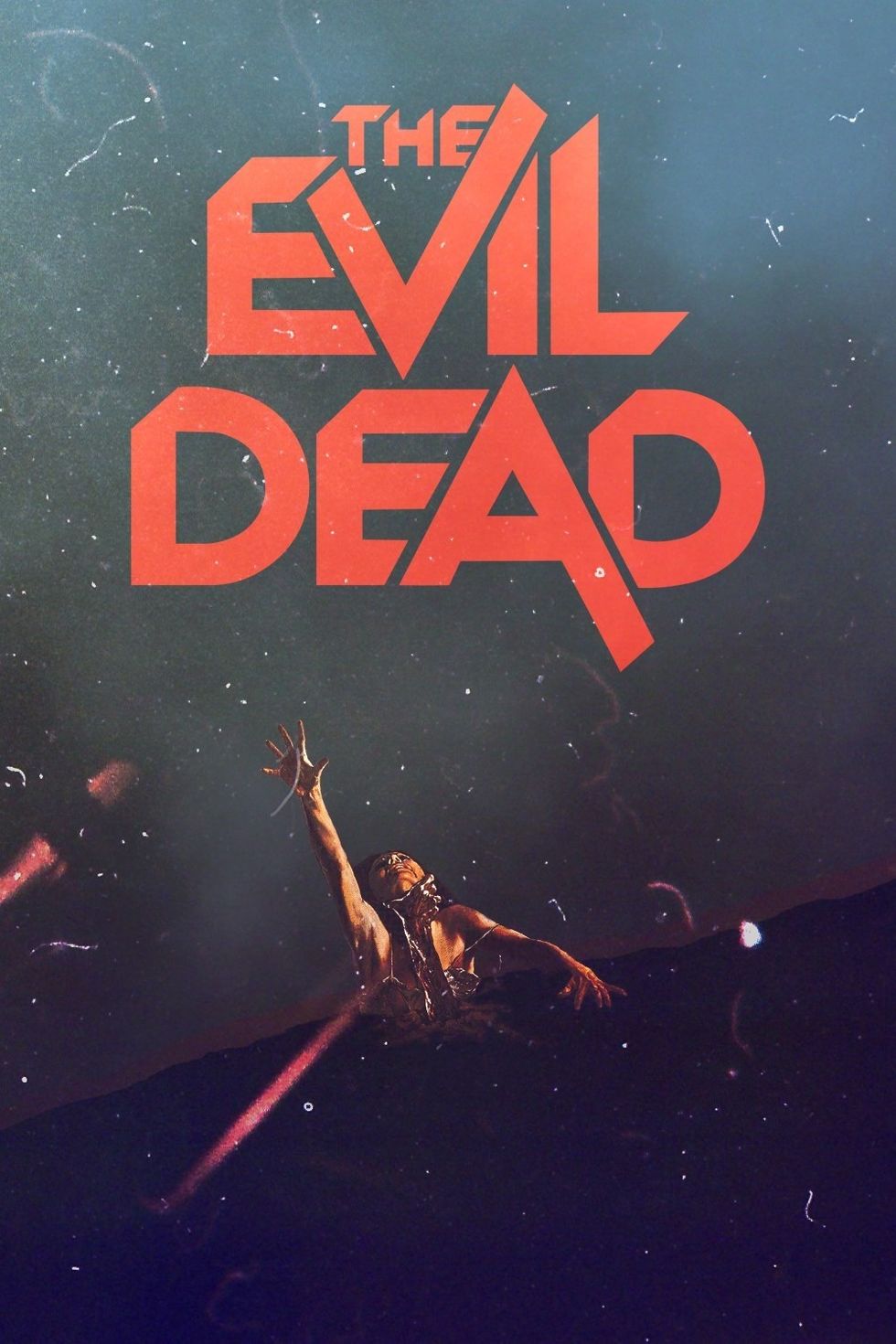
thenextissuepodcast.files.wordpress.com
This auspicious feature debut from Sam Raimi -- shot on 16mm in the woods of Tennesse for around $350,000 -- secured the young director's cult status as a creative force to be reckoned with. The nominal plot involves five vacationing college kids -- Ash (Bruce Campbell), his girlfriend Linda (Betsy Baker), and their classmates Cheryl (Ellen Sandweiss), Scott (Hal Delrich) and Shelly (Sarah York) -- making an unplanned stopover in an abandoned mountain cabin surrounded by impenetrable woods. Before settling in for the night, they come across an ancient-looking occult tome filled with dense hieroglyphics and macabre illustrations, a dagger fashioned from human bones, and a reel-to-reel tape recorder. The taped message, dictated by a professor of archaeology, describes the contents of the Sumerian "Book of the Dead," filled with incantations used to bring otherworldly demons to life, giving them license to possess the living. The message goes on to explain that those possessed by these demons can only be stopped by total bodily dismemberment. When played among the group later that evening, the professor's recorded translations of the ritual chants traumatize the strangely prescient Shelly ... and simultaneously release an ominous presence from the depths of the forest. The evil spirits take to their dirty work with gusto, first assuming control of Shelly and transforming her into a cackling, murderous hag with superhuman strength; the others imprison her in the fruit cellar and chain the trapdoor shut. The spirits then begin to possess the other women, including Linda -- who immediately turns on Ash with a barrage of punches and sadistic taunts. Unable to bring himself to chop up his lover's corpse, Ash gives her a more customary burial in the woods -- which proves to be a big mistake. As the others succumb to demonic influence, Ash's horrific predicament becomes increasingly grim until, when all hope seems lost, he stumbles upon a final, desperate solution to the ghoulish onslaught ... well, maybe not. Despite the shoestring production values, Raimi has fashioned a tight, lightning-paced fever dream of a movie, filled with operatic overacting and outrageously gory effects that give the project a comic-book feel. Based on an earlier 8mm short titled Within the Woods, this feature version was fraught with distribution difficulties before finding its first audience overseas. After considerable word of mouth (and a glowing endorsement from horror author Stephen King), the film became a hit on home video, where it achieved further notoriety thanks to its highly-publicized banning in Britain amid the notorious "Video Nasties" censorship campaign. Raimi, along with producer Robert Tapert, writer Scott Spiegel and much of the same crew, cranked up the story's comic aspects several dozen notches for the rollicking semi-remake, Evil Dead 2: Dead by Dawn. ~ Cavett Binion, Rovi
18. POLTERGEIST (1982)

With Poltergeist, directed by Tobe Hopper, Steven Spielberg had his first great success as a producer. Released around the same time as Spielberg's E.T., the film presents the dark side of Spielberg's California suburban track homes. The film centers on the Freeling family, a typical middle-class family living in the peaceful Cuesta Verde Estates. The father, Steve (Craig T. Nelson), has fallen asleep in front of the television, and the dog saunters around the house revealing the other family members -- Steve's wife Diane (JoBeth Williams), sixteen-year-old daughter Dana (Dominique Dunne), eight-year-old son Robbie (Oliver Robins), and five-year-old Carol Ann (Heather O'Rourke). Soon strange things begin to happen around the house; the pet canary dies, mysterious storms occur, and Carol Ann is summoned to the TV set, where a strange shaft of green light hits her and causes the room to shake ("They're he-e-ere!"). As curious events continue, Carol Ann is repeatedly drawn to the television, where she begins to talk to "the TV people." Soon Carol Ann is sucked into a closet, disappearing from this reality plane. Unable to find his daughter, Steve consults Dr. Lesh (Beatrice Straight), a para-psychologist from a nearby college. Lesh finds that paranormal phenomena is so strong in the Freelong household she is unable to deal with it and sends for clairvoyant and professional exorcist Tangina (Zelda Rubinstein) to examine the house in hopes of finding Carol Ann. Tangina makes a horrifying discovery: Carol Ann is alive and in the house, but is being held on another spectral plane. ~ Paul Brenner, Rovi
19. A NIGHTMARE ON ELM STREET (1984)

A group of teenagers are terrorized by "Freddy Krueger", an evil being from another world who gets to his victims by entering their dreams and killing them with gloves that have knife blades attached to each finger.
20. THE SILENCE OF THE LAMBS (1991)

In this multiple Oscar-winning thriller, Jodie Foster stars as Clarice Starling, a top student at the FBI's training academy whose shrewd analyses of serial killers lands her a special assignment: the FBI is investigating a vicious murderer nicknamed Buffalo Bill, who kills young women and then removes the skin from their bodies. Jack Crawford (Scott Glenn) wants Clarice to interview Dr. Hannibal Lecter (Anthony Hopkins), a brilliant psychiatrist who is also a violent psychopath, serving life behind bars for various acts of murder and cannibalism. Crawford believes that Lecter may have insight into this case and that Starling, as an attractive young woman, may be just the bait to draw him out. Lecter does indeed know something of Buffalo Bill, but his information comes with a price: in exchange for telling what he knows, he wants to be housed in a more comfortable facility. More important, he wants to speak with Clarice about her past. He skillfully digs into her psyche, forcing her to reveal her innermost traumas and putting her in a position of vulnerability when she can least afford to be weak. The film mingles the horrors of criminal acts with the psychological horrors of Lecter's slow-motion interrogation of Clarice and of her memories that emerge from it. ~ Mark Deming, Rovi
21. THE BLAIR WITCH PROJECT (1999)
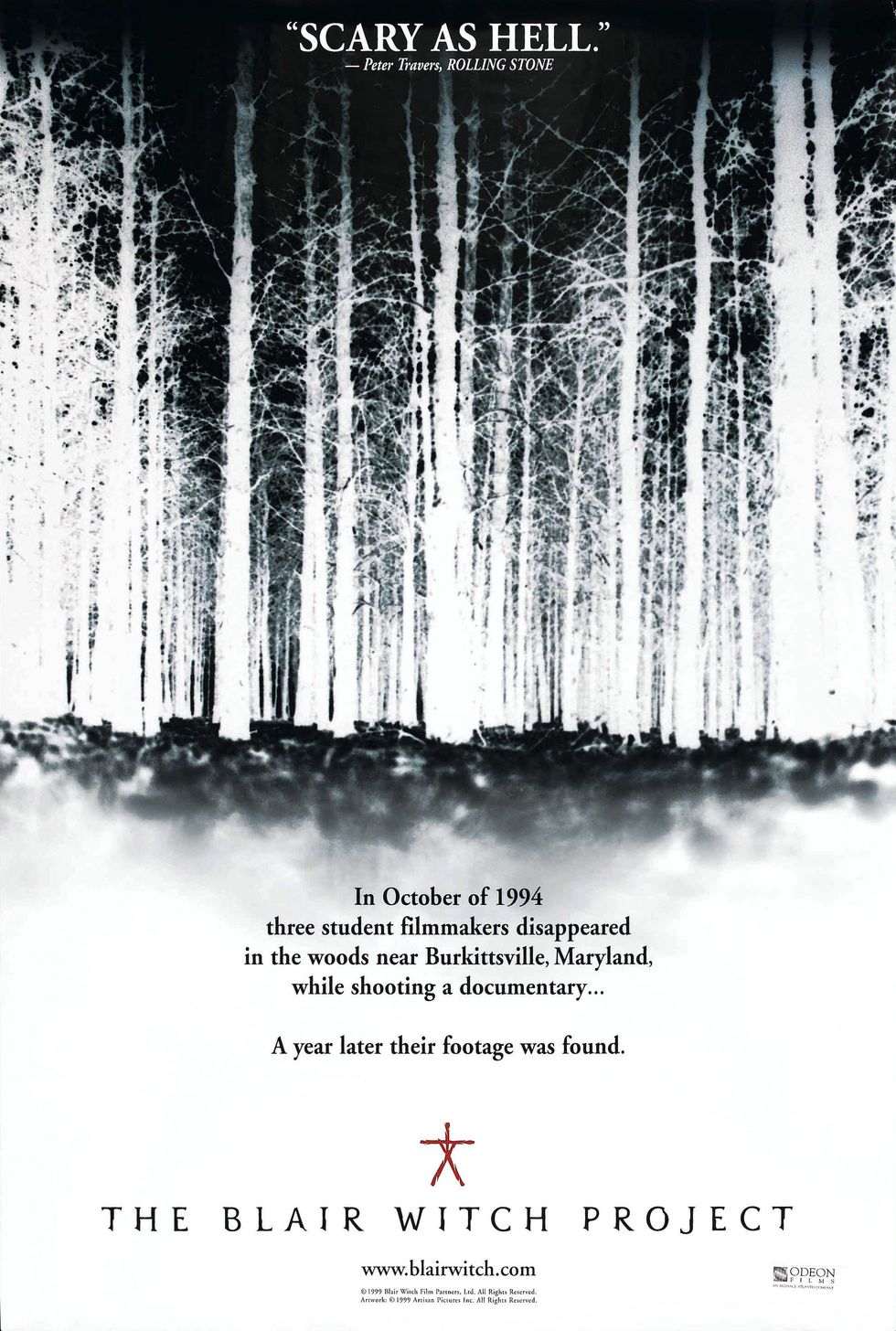
thatwasabitmental.files.wordpress.com
Combining Hi-8 video with black-and-white 16 mm film, this film presents a raw look at what can happen when college students forego common sense and enter the world of voodoo and witchcraft. Presented as a straightforward documentary, the film opens with a title card explaining that in 1994, three students went into the Maryland back woods to do a film project on the Blair Witch incidents. These kids were never seen again, and the film you are about to see is from their recovered equipment, found in the woods a year later. The entire movie documents their adventures leading up to their final minutes. The Blair Witch incident, as we initially learn from the local town elders, is an old legend about a group of witches who tortured and killed several children many years ago. Everyone in town knows the story and they're all sketchy on the details. Out in the woods and away from their parked car (and civilization), what starts as a school exercise turns into a nightmare when the three kids lose their map. Forced to spend extra days finding their way out, the kids then start to hear horrific sounds outside their tents in the pitch-black middle of night. They also find strange artifacts from (what can only be) the Blair Witch, still living in the woods. Frightened, they desperately try to find their way out of the woods, with no luck. Slowly these students start to unravel, knowing they have no way of getting out, no food, and it's getting cold. Each night they are confronted with shrieking and sounds so haunting that they are convinced someone is following them, and they quickly begin to fear for their lives. The film premiered in the midnight movie section at the 1999 Sundance Film Festival. ~ Chris Gore, Rovi
22. SAW (2004)
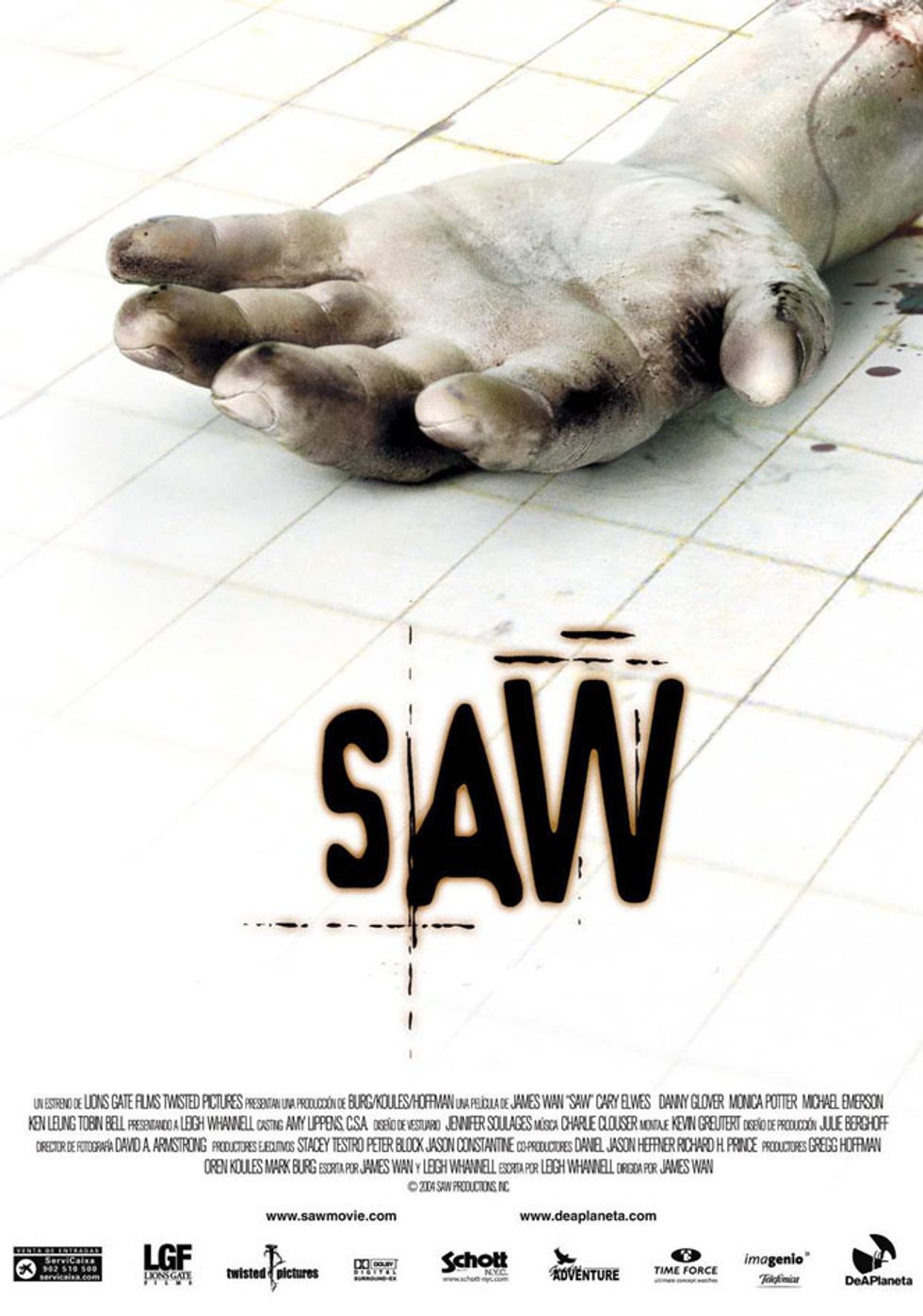
The directorial debut from filmmaker James Wan, this psychological thriller comes from the first screenplay by actor Leigh Whannell, who also stars. Whannell plays Adam, one of two men chained up in a mysterious chamber. The other, Dr. Gordon (Cary Elwes), like Adam, has no idea how either of them got there. Neither of them are led to feel optimistic by the man lying between them dead of a self-inflicted gunshot wound. Together, Adam and Dr. Gordon attempt to piece together what has happened to them and who the sadistic madman behind their imprisonment is. Also starring Danny Glover and Monica Potter, Saw premiered at the 2004 Sundance Film Festival. ~ Matthew Tobey, Rovi
23. LET THE RIGHT ONE IN (2008)
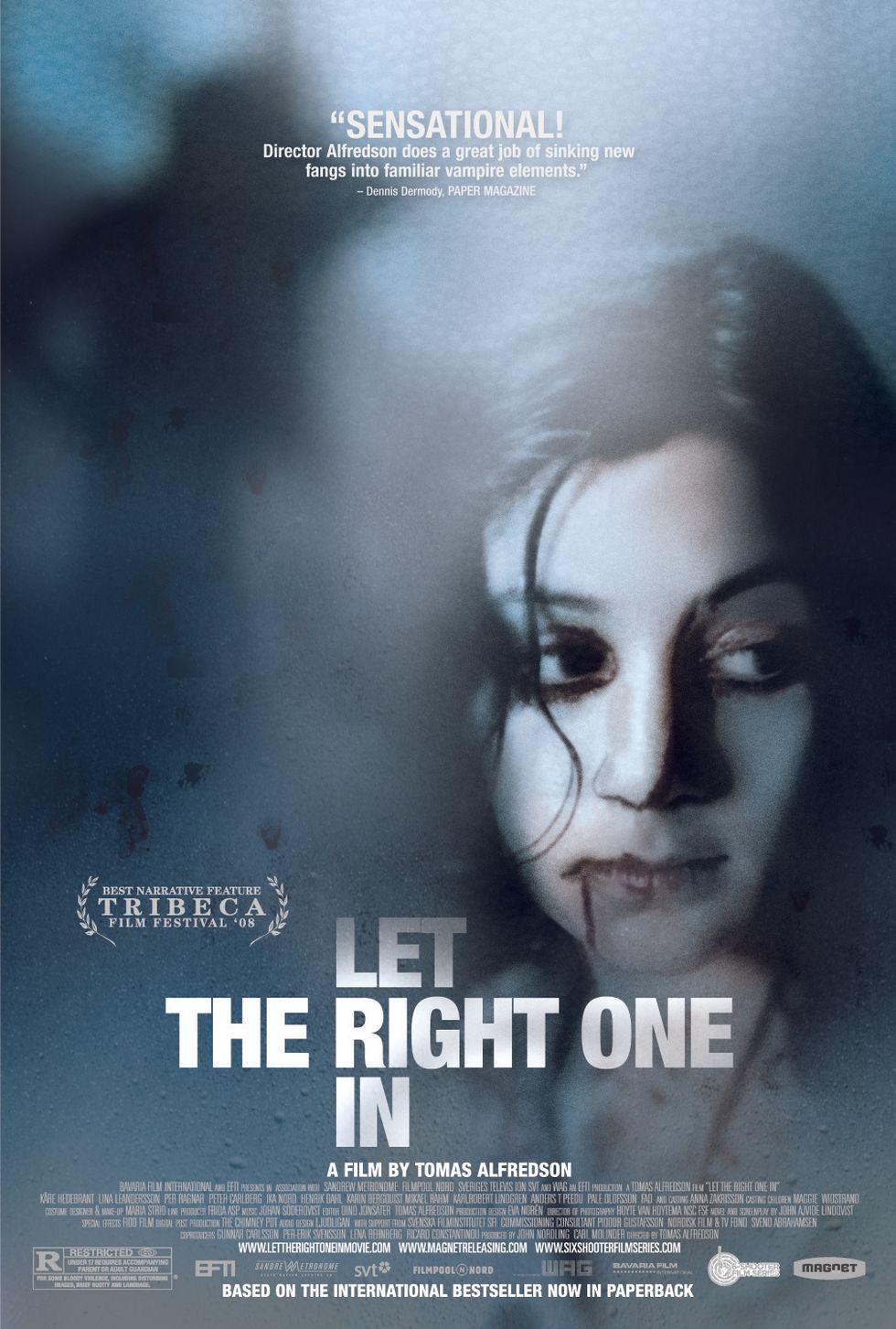
A 12-year-old boy befriends a mysterious young girl whose appearance in town suspiciously coincides with a horrifying series of murders in director Tomas Alfredson's adaptation of the book by author John Ajvide Lindqvist, who also wrote the screenplay. Oskar is a young boy who can't seem to shake off the local bullies, but all of that begins to change when a new neighbor moves in next door. After striking up an innocent friendship with his eccentric next-door neighbor, Oskar realizes that she is the vampire responsible for the recent rash of deaths around town. Despite the danger, however, Oskar's friendship with the girl ultimately takes precedence over his fear of her.
24. THE CABIN IN THE WOODS (2012)
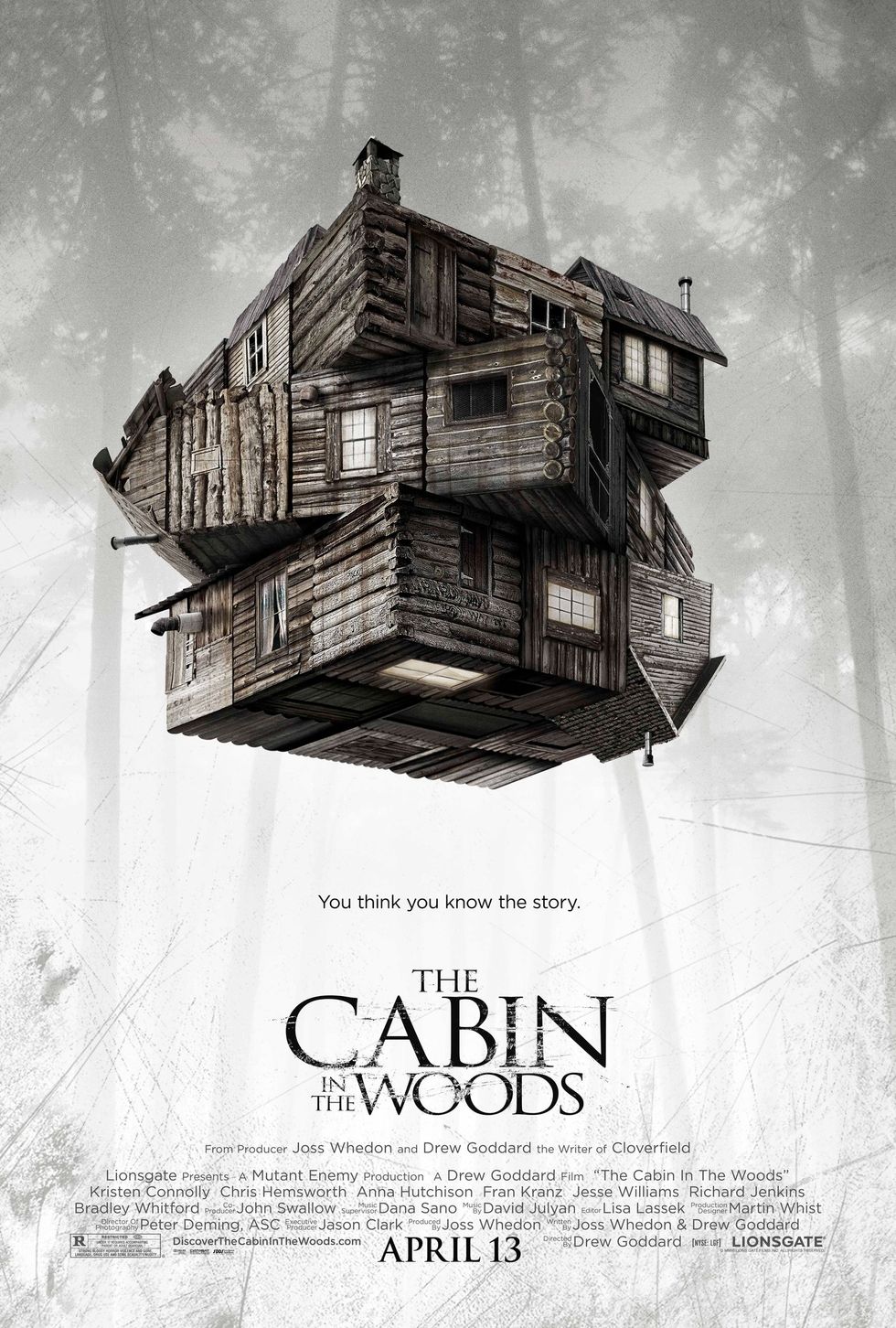
Five friends go to a remote cabin in the woods. Bad things happen. If you think you know this story, think again. From fan favorites Joss Whedon and Drew Goddard comes The Cabin in the Woods, a mind blowing horror film that turns the genre inside out. -- (C) Lionsgate
25.THE CONJURING (2013)
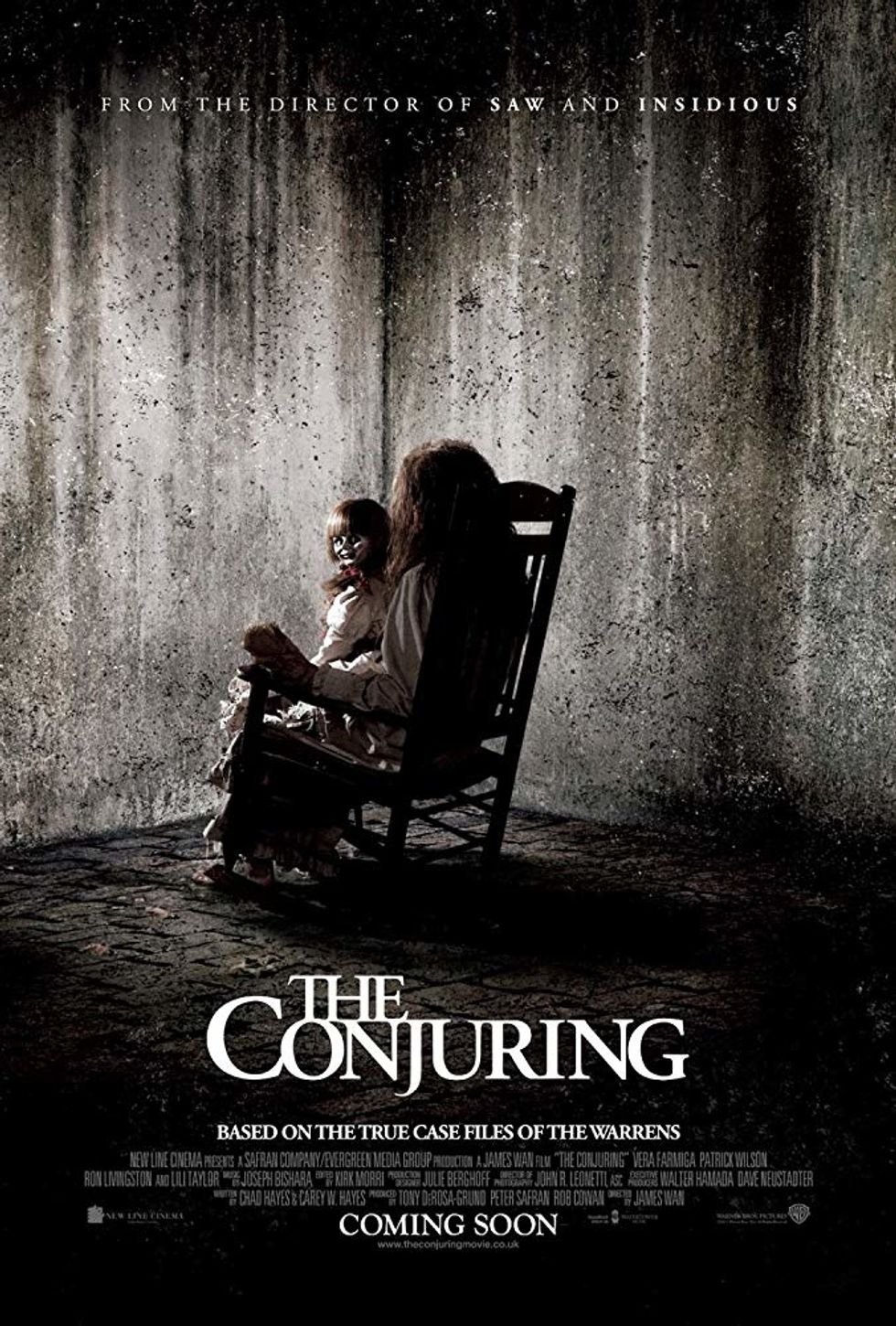
Before there was Amityville, there was Harrisville. "The Conjuring," tells the true story of Ed and Lorraine Warren (Patrick Wilson, Vera Farmiga), world renowned paranormal investigators, who were called to help a family terrorized by a dark presence in a secluded farmhouse. Forced to confront a powerful demonic entity, the Warrens find themselves caught in the most horrifying case of their lives. -- (C) WB
26. THE BABADOOK (2014)

Six years after the violent death of her husband, Amelia (Essie Davis) is at a loss. She struggles to discipline her 'out of control' 6 year-old, Samuel (Noah Wiseman), a son she finds impossible to love. Samuel's dreams are plagued by a monster he believes is coming to kill them both. When a disturbing storybook called 'The Babadook' turns up at their house, Samuel is convinced that the Babadook is the creature he's been dreaming about. His hallucinations spiral out of control, he becomes more unpredictable and violent. Amelia, genuinely frightened by her son's behaviour, is forced to medicate him. But when Amelia begins to see glimpses of a sinister presence all around her, it slowly dawns on her that the thing Samuel has been warning her about may be real. (C) IFC
27. IT FOLLOWS (2015)

After a strange sexual encounter, a teenager finds herself haunted by nightmarish visions and the inescapable sense that something is after her. (C) Radius-TWC
28. THE WITCH (2016)

In this exquisitely made and terrifying new horror film, the age-old concepts of witchcraft, black magic and possession are innovatively brought together to tell the intimate and riveting story of one family's frightful unraveling in the New England wilderness circa 1630. New England, 1630. Upon threat of banishment by the church, an English farmer leaves his colonial plantation, relocating his wife and five children to a remote plot of land on the edge of an ominous forest - within which lurks an unknown evil. Strange and unsettling things begin to happen almost immediately - animals turn malevolent, crops fail, and one child disappears as another becomes seemingly possessed by an evil spirit. With suspicion and paranoia mounting, family members accuse teenage daughter Thomasin of witchcraft, charges she adamantly denies. As circumstances grow more treacherous, each family member's faith, loyalty and love become tested in shocking and unforgettable ways. Writer/director Robert Eggers' debut feature, which premiered to great acclaim at the 2015 Sundance Film Festival - winning the Best Director Prize in the U.S. Narrative Competition - painstakingly recreates a God-fearing New England decades before the 1692 Salem witch trials, in which religious convictions tragically turned to mass hysteria. Told through the eyes of the adolescent Thomasin - in a star-making turn by newcomer Anya Taylor-Joy - and supported by mesmerizing camera work and a powerful musical score, THE WITCH is a chilling and groundbreaking new take on the genre.
29. IT (2017)

New Line Cinema's horror thriller "IT," directed by Andy Muschietti ("Mama"), is based on the hugely popular Stephen King novel of the same name, which has been terrifying readers for decades. When children begin to disappear in the town of Derry, Maine, a group of young kids are faced with their biggest fears when they square off against an evil clown named Pennywise, whose history of murder and violence dates back for centuries.
30. GET OUT (2017)

Now that Chris and his girlfriend, Rose, have reached the meet-the-parents milestone of dating, she invites him for a weekend getaway upstate with Missy and Dean. At first, Chris reads the family's overly accommodating behavior as nervous attempts to deal with their daughter's interracial relationship, but as the weekend progresses, a series of increasingly disturbing discoveries lead him to a truth that he could have never imagined.
31. A QUIET PLACE (2018)

In the modern horror thriller A QUIET PLACE, a family of four must navigate their lives in silence after mysterious creatures that hunt by sound threaten their survival. If they hear you, they hunt you.
- 22 Halloween Movies That You Should Definitely Watch This Year ›
- 5 Movies To Watch On Halloween If You Don't Like Scary Movies ›
- 10 Scary Movies That Will Leave You Feeling Extra Spooked This Fall ›
- None ›

